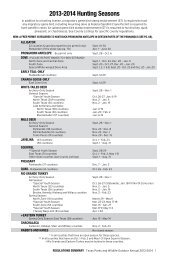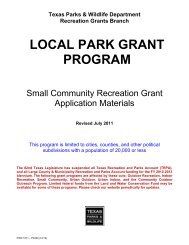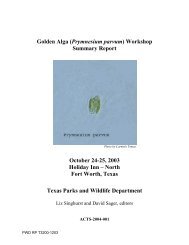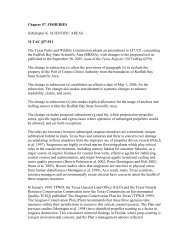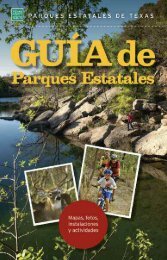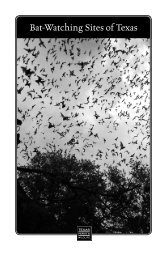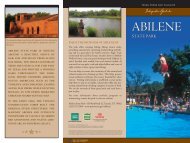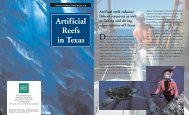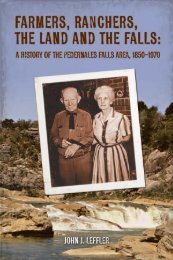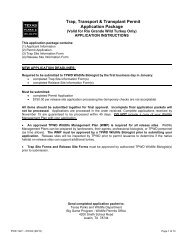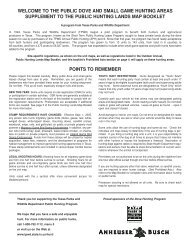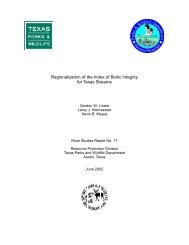Guadalupe River State Park and Honey Creek State Natural Area
Guadalupe River State Park and Honey Creek State Natural Area
Guadalupe River State Park and Honey Creek State Natural Area
You also want an ePaper? Increase the reach of your titles
YUMPU automatically turns print PDFs into web optimized ePapers that Google loves.
STEWARDSHIP OF<br />
GUADALUPE RIVER STATE PARK<br />
Undeveloped l<strong>and</strong> such as<br />
<strong>Guadalupe</strong> <strong>River</strong> <strong>State</strong><br />
<strong>Park</strong> <strong>and</strong> <strong>Honey</strong> <strong>Creek</strong><br />
<strong>State</strong> <strong>Natural</strong> <strong>Area</strong> are<br />
becoming increasingly<br />
rare. Rapid development<br />
continues to destroy <strong>and</strong><br />
fragment habitat in the<br />
surrounding area. Changes<br />
in recreation patterns <strong>and</strong><br />
increased numbers of<br />
visitors have placed these<br />
precious resources at risk.<br />
An important step toward ensuring the future of this site is to<br />
appreciate <strong>and</strong> gain a better underst<strong>and</strong>ing of it. We encourage<br />
you as a visitor <strong>and</strong> user of this sensitive area to join us in this<br />
effort.<br />
• Attend <strong>and</strong> take advantage of interpretive programs offered<br />
in the park, including the guided tour of <strong>Honey</strong> <strong>Creek</strong> <strong>and</strong><br />
Saturday evening amphitheater programs.<br />
• Protect the natural <strong>and</strong> historical resources of the area by<br />
staying out of closed areas.<br />
• Learn more about German settlement <strong>and</strong> l<strong>and</strong> management<br />
as well as natural resources in the Texas Hill Country.<br />
• Stay on designated trails to further reduce impacts.<br />
• Help keep the area clean by not littering, <strong>and</strong> take nothing<br />
but photographs when you leave.<br />
• Become a volunteer, join the Friends of <strong>Guadalupe</strong> <strong>River</strong><br />
<strong>State</strong> <strong>Park</strong> <strong>and</strong> <strong>Honey</strong> <strong>Creek</strong> <strong>State</strong> <strong>Natural</strong> <strong>Area</strong>, or help by<br />
making a monetary donation.<br />
<strong>Guadalupe</strong> <strong>River</strong> SP <strong>and</strong> <strong>Honey</strong> <strong>Creek</strong> SNA<br />
3350 <strong>Park</strong> Road 31, Spring Branch, TX 78070<br />
(830) 438-2656 • www.tpwd.state.tx.us/guadaluperiver/<br />
Friends of <strong>Guadalupe</strong> <strong>River</strong>/<strong>Honey</strong> <strong>Creek</strong>, Inc.<br />
www.honeycreekfriends.com<br />
texas parks <strong>and</strong> wildlife<br />
Interpretive Guide to:<br />
GUADALUPE<br />
RIVER<br />
STATE PARK AND HONEY<br />
CREEK STATE NATURAL AREA<br />
CREAMY LIMESTONE CLIFFS AND<br />
TOWERING CYPRESS TREES GRIP<br />
THE BANKS OF A SEEMINGLY LAZY<br />
AND DOCILE RIVER TO CREATE THE<br />
FOCAL POINT OF GUADALUPE RIVER<br />
STATE PARK. THIS IDYLLIC SET<br />
TING IS THE ONLY DEVELOPED<br />
PUBLIC ACCESS POINT TO THE<br />
UPPER GUADALUPE, ONE OF THE<br />
MOST SCENIC RIVER SECTIONS IN<br />
TEXAS. YET THERE IS SO MUCH<br />
MORE TO GUADALUPE RIVER STATE<br />
PARK THAN THE BEAUTIFUL RIVER.<br />
LEAVE THE CROWDS BEHIND AND<br />
DISCOVER OTHER WONDERS OF<br />
THIS BEAUTIFUL PARK.<br />
BEYOND THE RIVER<br />
Explore one of the many trails at the park to discover its<br />
dramatic scenery. Exposed geology is an often unnoticed<br />
treasure <strong>and</strong> hides a secret we all must appreciate. Over<br />
eons, slightly acidic water literally dissolves the prominent<br />
limestone to form a rugged appearance reminiscent<br />
of a wild country from a forgotten past.<br />
The true treasure of the geology, however, is not its<br />
appearance but rather, what it holds underground. A<br />
close look at the exposed limestone reveals honeycombed<br />
features that capture rainfall, allowing it to drain <strong>and</strong><br />
infiltrate underground, ultimately recharging the Edwards<br />
<strong>and</strong> Trinity aquifers. This topography, known as karst,<br />
provides the lifeblood necessary for all who live within its<br />
corridors – fresh water.<br />
Yet this l<strong>and</strong>scape continues to disappear at alarming<br />
rates as developmental sprawl exp<strong>and</strong>s from the surrounding<br />
urban centers. What we put into the ground<br />
ultimately comes back out; therefore, we must be<br />
cautious with pollutants <strong>and</strong> other chemicals. Karst<br />
l<strong>and</strong>scapes are a secret we all must appreciate.<br />
Karst geology allows<br />
rainfall to infiltrate the<br />
surface <strong>and</strong> percolate<br />
into the aquifer.<br />
Proud Sponsor of Texas <strong>Park</strong>s <strong>and</strong> Wildlife Programs<br />
In accordance with Texas <strong>State</strong> Depository Law, this publication is available at<br />
the Texas <strong>State</strong> Publications Clearinghouse <strong>and</strong>/or Texas Depository Libraries.<br />
© 2007 TPWD. PWD BR P4505-040G (5/07) Printed on recycled paper.<br />
✯✯ ✯ ✯✯
G U A D A L U P E R I V E R S T A T E P A R K A N D H O N E Y C R E E K S T A T E N A T U R A L A R E A<br />
HONEY CREEK SNA<br />
RESPECTING THE RIVER<br />
Take a guided tour to <strong>Honey</strong> <strong>Creek</strong> <strong>and</strong> be<br />
rewarded with a breathtaking journey. The<br />
creek is in <strong>Honey</strong> <strong>Creek</strong> <strong>State</strong> <strong>Natural</strong> <strong>Area</strong>,<br />
which adjoins the park. This fragile area has been set<br />
aside to protect the pristine creek habitat. Ancient oaks<br />
laden with wisps of Spanish moss <strong>and</strong> centuries-old<br />
cypress trees join pecan, walnut, cedar elm <strong>and</strong> Texas<br />
oak to form a forest canopy. Below is a lush understory of<br />
dwarf palmettos, switchgrass, maidenhair ferns <strong>and</strong><br />
columbine.<br />
Protection, education, research, <strong>and</strong> the encouragement<br />
of thoughtful appreciation are all primary purposes of<br />
this site. Old-growth Ashe juniper trees provide habitat<br />
for the endangered golden-cheeked warbler. The riparian<br />
area <strong>and</strong> water resources host several other rare <strong>and</strong><br />
threatened species. Restoration efforts have increased<br />
st<strong>and</strong>s of native grasses. In collaboration with other<br />
agencies <strong>and</strong> universities, research projects are revealing<br />
relationships between habitat improvement, spring flow<br />
<strong>and</strong> water quality.<br />
As a <strong>State</strong> <strong>Natural</strong> <strong>Area</strong>, activities at <strong>Honey</strong> <strong>Creek</strong> are<br />
limited to those that have minimal impact to the site <strong>and</strong><br />
promote thoughtful underst<strong>and</strong>ing. Access to the site is<br />
limited to guided tours.<br />
“The mountains are cedar bedecked, the valleys<br />
contain delightful prairies with occasional groves<br />
of trees of ten or twelve varieties of oaks.”<br />
C. Hugo Claus (c. 1875), description of the<br />
Cibolo <strong>and</strong> <strong>Guadalupe</strong> <strong>River</strong> Valley<br />
KNOWING THE PAST HELPS<br />
US PLAN FOR THE FUTURE<br />
The fresh, clean, cool waters of the <strong>Guadalupe</strong> <strong>River</strong> have been the<br />
life force for the plants animals <strong>and</strong> humans using this area for over<br />
12,000 years. Prehistoric people walked the river’s edge you are<br />
walking now. They saw the same cliffs <strong>and</strong> likely enjoyed the river<br />
<strong>and</strong> its natural beauty as they hunted, fished, gathered <strong>and</strong><br />
processed plant resources.<br />
Spanish explorers discovered these wonders in the early 1700s, but<br />
it was over 100 years before European immigrants, mostly German,<br />
began to settle here. Their journals <strong>and</strong> letters described vast<br />
prairies, wildfires <strong>and</strong> migrating bison herds. These grassl<strong>and</strong>s<br />
appeared to be an endless supply of food for domestic livestock. But<br />
the suppression of fire, fragmentation by fencing, <strong>and</strong> overgrazing<br />
by increasing numbers of cows <strong>and</strong> goats, decimated the very<br />
resource that had attracted the settlers. As a result, native Ashe<br />
juniper woodl<strong>and</strong>s (cedar) became the dominant habitat.<br />
The <strong>Guadalupe</strong> is a true Texas river,<br />
flowing entirely within the state.<br />
The four-mile portion within the<br />
park is wild, rugged <strong>and</strong> untamed by<br />
dams. Respect is required; river conditions<br />
can change<br />
instantly since the<br />
river flows free <strong>and</strong> is<br />
subject to intense flash<br />
flooding.<br />
The river is a ribbon of life providing<br />
a healthy ecosystem for wildlife as well<br />
as people. Its watershed is a major artery of<br />
fresh water for central Texas cities, industry, agriculture<br />
<strong>and</strong> recreation. Despite recognition of the<br />
river’s water quality <strong>and</strong> scenery, overuse threatens its flow. In 2002<br />
the national nonprofit conservation organization American <strong>River</strong>s<br />
ranked the <strong>Guadalupe</strong> <strong>River</strong> as one of the top 10 most endangered<br />
rivers in the United <strong>State</strong>s. Please demonstrate respect for this precious<br />
Texas resource through safe <strong>and</strong> responsible use of the river.<br />
The Nature of the <strong>Guadalupe</strong><br />
One of the most compelling attributes of the park is its ecological<br />
diversity. The drive from the park headquarters to the river exposes<br />
wide-ranging habitats. Initially, moving through upl<strong>and</strong>s of classic<br />
Untamed by dams,<br />
the river is subject<br />
to flash flooding,<br />
which can reach<br />
above the cliff tops.<br />
Texas Hill Country, notice the open grassl<strong>and</strong>s scattered<br />
with oak mottes. Closer inspection reveals many species of<br />
grasses <strong>and</strong> wildflowers. St<strong>and</strong>s of thick Ashe juniper<br />
become dominant on steep rock slopes <strong>and</strong> valleys of the<br />
park, providing welcome shade to hikers <strong>and</strong> campers.<br />
Humidity increases near the river. This riparian habitat,<br />
where water meets l<strong>and</strong>, is home to the highest concentration<br />
of wildlife.<br />
The diverse plant life provides habitat to many invertebrates,<br />
fish <strong>and</strong> mammals, as well as over 160 species of<br />
birds that call this park home. Rare <strong>and</strong> endangered species<br />
survive at the park, including the Cagle’s map turtle,<br />
<strong>Guadalupe</strong> bass, golden-cheeked warbler, <strong>and</strong> the Comal<br />
blind salam<strong>and</strong>er. The diverse mammal populations provide<br />
excellent opportunities for wildlife viewing. The nature of<br />
<strong>Guadalupe</strong> awaits your discovery <strong>and</strong> appreciation.<br />
Recognizing how past cultures used the l<strong>and</strong>, <strong>and</strong> the results that<br />
followed, can help us develop preservation plans for future sustainability.<br />
Every visitor – past, present or future – leaves a mark on the<br />
face of the resource that is <strong>Guadalupe</strong> <strong>River</strong> <strong>State</strong> <strong>Park</strong>.<br />
TPWD selectively thinned Ashe juniper (cedar) woodl<strong>and</strong>s<br />
to restore <strong>and</strong> balance similar natural conditions prior to<br />
European settlement 200 years ago. Prescribed fire now<br />
maintains this community.



